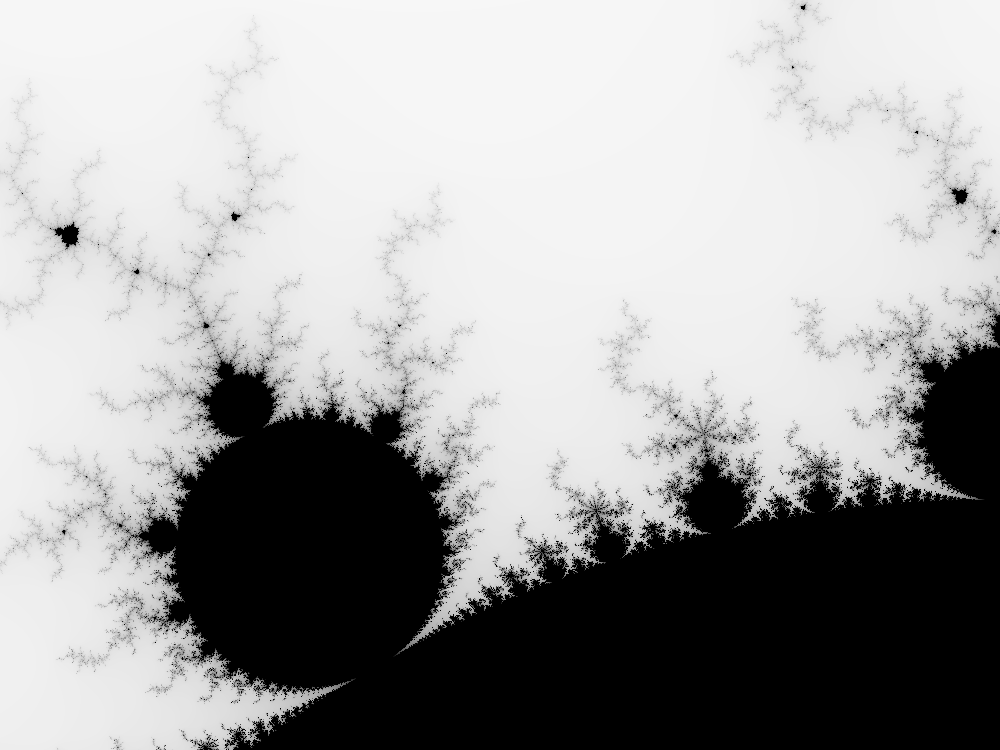Rust 写的曼德勃罗集绘图器
🏷 💻IT
取自《Rust 程序设计》一书。
命令target/release/mandelbrot mandelbrot.png 1000x750 -1.20,0.35 -1,0.20的运行效果:
可查看我更新后的代码,有空我弄成 WASM 版本。主体代码如下:
use num::Complex;
use rayon::prelude::*;
/// Try to determine if `c` is in the Mandelbrot set, using at most `limit`
/// iterations to decide.
///
/// If `c` is not a member, return `Some(i)`, where `i` is the number of
/// iterations it took for `c` to leave the circle of radius two centered on the
/// origin. If `c` seems to be a member (more precisely, if we reached the
/// iteration limit without being able to prove that `c` is not a member),
/// return `None`.
fn escape_time(c: Complex<f64>, limit: usize) -> Option<usize> {
let mut z = Complex { re: 0.0, im: 0.0 };
for i in 0..limit {
if z.norm_sqr() > 4.0 {
return Some(i);
}
z = z * z + c;
}
None
}
use std::str::FromStr;
/// Parse the string `s` as a coordinate pair, like `"400x600"` or `"1.0,0.5"`.
///
/// Specifically, `s` should have the form <left><sep><right>, where <sep> is
/// the character given by the `separator` argument, and <left> and <right> are both
/// strings that can be parsed by `T::from_str`.
///
/// If `s` has the proper form, return `Some<(x, y)>`. If it doesn't parse
/// correctly, return `None`.
fn parse_pair<T: FromStr>(s: &str, separator: char) -> Option<(T, T)> {
match s.find(separator) {
None => None,
Some(index) => match (T::from_str(&s[..index]), T::from_str(&s[index + 1..])) {
(Ok(l), Ok(r)) => Some((l, r)),
_ => None,
},
}
}
/// Parse a pair of floating-point numbers separated by a comma as a complex
/// number.
fn parse_complex(s: &str) -> Option<Complex<f64>> {
match parse_pair(s, ',') {
Some((re, im)) => Some(Complex { re, im }),
None => None,
}
}
/// Given the row and column of a pixel in the output image, return the
/// corresponding point on the complex plane.
///
/// `bounds` is a pair giving the width and height of the image in pixels.
/// `pixel` is a (column, row) pair indicating a particular pixel in that image.
/// The `upper_left` and `lower_right` parameters are points on the complex
/// plane designating the area our image covers.
fn pixel_to_point(
bounds: (usize, usize),
pixel: (usize, usize),
upper_left: Complex<f64>,
lower_right: Complex<f64>,
) -> Complex<f64> {
let (width, height) = (
lower_right.re - upper_left.re,
upper_left.im - lower_right.im,
);
Complex {
re: upper_left.re + pixel.0 as f64 * width / bounds.0 as f64,
im: upper_left.im - pixel.1 as f64 * height / bounds.1 as f64,
// Why subtraction here? pixel.1 increases as we go down,
// but the imaginary component increases as we go up.
}
}
/// Render a rectangle of the Mandelbrot set into a buffer of pixels.
///
/// The `bounds` argument gives the width and height of the buffer `pixels`,
/// which holds one grayscale pixel per byte. The `upper_left` and `lower_right`
/// arguments specify points on the complex plane corresponding to the upper-
/// left and lower-right corners of the pixel buffer.
fn render(
pixels: &mut [u8],
bounds: (usize, usize),
upper_left: Complex<f64>,
lower_right: Complex<f64>,
) {
assert!(pixels.len() == bounds.0 * bounds.1);
for row in 0..bounds.1 {
for column in 0..bounds.0 {
let point = pixel_to_point(bounds, (column, row), upper_left, lower_right);
pixels[row * bounds.0 + column] = match escape_time(point, 255) {
None => 0,
Some(count) => 255 - count as u8,
};
}
}
}
use image::save_buffer;
use image::ColorType;
use image::ImageError;
/// Write the buffer `pixels`, whose dimensions are given by `bounds`, to the
/// file named `filename`.
fn write_image(filename: &str, pixels: &[u8], bounds: (usize, usize)) -> Result<(), ImageError> {
save_buffer(
filename,
&pixels,
bounds.0 as u32,
bounds.1 as u32,
ColorType::L8,
)
}
use std::env;
fn main() {
let args: Vec<String> = env::args().collect();
if args.len() != 5 {
eprintln!("Usage: {} FILE PIXELS UPPERLEFT LOWERRIGHT", args[0]);
eprintln!(
"Example: {} mandel.png 1000x750 -1.20,0.35 -1,0.20",
args[0]
);
std::process::exit(1);
}
let bounds = parse_pair(&args[2], 'x').expect("error parsing image dimensions");
let upper_left = parse_complex(&args[3]).expect("error parsing upper left corner point");
let lower_right = parse_complex(&args[4]).expect("error parsing lower right corner point");
let mut pixels = vec![0; bounds.0 * bounds.1];
// Scope of slicing up `pixels` into horizontal bands.
{
let bands: Vec<(usize, &mut [u8])> = pixels.chunks_mut(bounds.0).enumerate().collect();
bands.into_par_iter().for_each(|(i, band)| {
let top = i;
let band_bounds = (bounds.0, 1);
let band_upper_left = pixel_to_point(bounds, (0, top), upper_left, lower_right);
let band_lower_right =
pixel_to_point(bounds, (bounds.0, top + 1), upper_left, lower_right);
render(band, band_bounds, band_upper_left, band_lower_right);
});
}
write_image(&args[1], &pixels, bounds).expect("error writing PNG file");
}